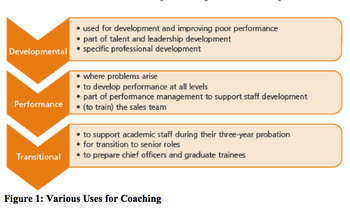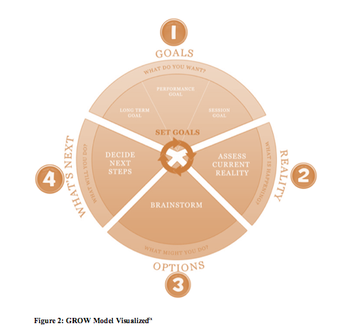Performance Coaching Utilizing the GROW Model
Add bookmark
Did you know that etymologically, the English term "coach" is derived from a medium of transport that traces its origins to the Hungarian word kocsi meaning "carriage" or "cart"? It was indeed named after the village where it was first made.
The first use of the term coaching to describe an instructor or trainer arose only in 1830 in Oxford University slang describing a tutor who ‘carries’ a student through an exam. Only one year later in 1831 it was used for the first time in relation to sports. Coaching has since then been used in language to describe the process to ’transport’ people from where they are, to where they want to be.
John Whitmore, who is one of the founders of the coaching GROW model, defines coaching as "unlocking a person’s potential to maximize their performance." There are various structures, models and methodologies of coaching. Most are designed to facilitate learning of a new behavior to enable personal and/or professional growth. There are also other forms of coaching to help the coachee (someone who is being coached) to improve a physical skill, like in a sport or performing art discipline.
Coaching is widely used across many modern organizations. According to the Chartered Institute of Personnel Development (CIPD), 51 percent of companies "consider coaching as a key part of learning development" and "crucial to their strategy", with 90 percent reporting that they "use coaching" for various reasons. Qa research found out in 2011 that 80 percent of organizations surveyed had used or are now using coaching. According to CIPD, the actual use of the coaching concept inside organizations varies widely:

When talking about coaching as a means to facilitate psychological or emotional growth it must be differentiated from therapeutic and counseling disciplines. When looking at some of the erratic senior management behaviors of the past, some of us may actually disagree, a client of coaching, in most cases, is considered rather healthy! So clearly there is a different purpose aimed at coaching them, which is to enable them to move forward from their present situation and/or perspective and grow.
One powerful coaching style is through asking questions in order to find opportunities that will challenge the coachee to find answers from within him or herself. This is also referred to as a "Socratic method" and shall facilitate the coachee as a learner to discover answers and new ways of being, based on their values, preferences and unique perspective. In the management literature a model that uses its basic concept and is widely used across the globe is the so called "GROW model." It was originally developed in the 1980s by Graham Alexander and racing champion Sir John Whitmore. A Google search conducted in April 2012 identified over 42 million mentions.
So what exactly does GROW stand for? It stands for:
Goals
Reality
Options
What’s Next

As you can see the GROW model effectively provides a framework for the four main stages of a coaching conversation. I will now explore the four main stages in more detail:
Stage 1 – GOALS (What do you want?)
After establishing rapport, the coach asks the coachee or proposes what the topic of the coaching conversation should be. It might happen that the coachee does not have a clear idea what he or she would like to talk about. Therefore it is even more important that the coach unravels any generalized topic and gets the coachee to focus on what it is he or she really would like to discuss. The aim during this stage of the process is to establish a goal for the coaching session in order to ensure that the coachee can walk out of the conversation with a clear deliverable.
Whether the coachee would like to discuss a long term goal, a performance goal or a session goal it doesn’t really matter. What matters more is that the coach needs to do some probing to drill the topic down until a realistic goal becomes clear. Effective coaching should produce defined outcomes and it is the responsibility of the coach to ensure the outcomes are made crystal clear for the coachee. As trivial as this stage might sound, during my coaching conversations I have found this stage to be both important and insightful since gaining this clarity often plays a pivotal role to resolve the actual issue.
Stage 2 – REALITY (What’s happening?)
For an effective coaching conversation, the majority of the time should be spent around this stage. This is the prime opportunity for the coach to shed some light of awareness into the coachee’s reality. It is also a golden opportunity for the coachee to gain new insights, raise his or her own awareness and be able to see a need or the issue better. During my coaching conversations I have found the entire coaching process to be much more effective if sufficient time has been invested into this stage of the process.
Stage 3 – OPTIONS (What might you do?)
At this stage the coachee will have described his or her reality in more detail. It is now down to the coach to help to generate some options and to get the coachee to agree how to take these forward and move into some clear actionable results. During this stage, the coach usually asks a number of open-ended questions. Here, effective coaches get the coachee to flush out a number of ideas and options to be ultimately agreed upon. If the coachee feels blocked for some reason or has a black out, it is fine to ask for the coach’s perspective during this brainstorming stage.
Stage 4 – WHAT’S NEXT (What will you do?)
This stage is also referred to as WRAP-UP and/or WAY FORWARD in the literature. But most importantly, it is action time now! You can immediately spot an effective coach at this stage. Why? Because only having gone rigorously through the previous three stages will enable some actions to become obvious and clear at this stage. It is not only important to have a coachee defining actionable outcomes, but also to get him or her to describe the reasons for their choices! Here it is fine for the coach to ask some closed questions to ensure the coachee has fully checked his or her position.
The beauty of the GROW model approach is that coachees by now have typically a number of actions available to them. And most importantly, these actions are predominantly based on their own wisdom, experience or creativity – albeit with some possible additions form the coach by the end. And this in return can help to drive both engagement and performance levels up.
It is important to highlight that coaching conversations using the GROW model don’t necessarily have to produce novel ideas or major innovations. It is rather important that the coach gets the coachee to reflect on previous thoughts with a sharper focus and confront the coachee to understand whether certain choices and actions proposed are desirable at the end. And most importantly, the coaching GROW model can be applied regardless of the seniority level involved.



















